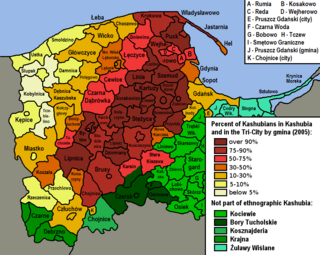
The Kashubians, also known as Cassubians or Kashubs, are a Lechitic ethnic group native to the historical region of Pomerania, including its eastern part called Pomerelia, in north-central Poland. Their settlement area is referred to as Kashubia. They speak the Kashubian language, which is classified as a separate language closely related to Polish.

Slavs are the largest European ethnolinguistic group. They speak the various Slavic languages, belonging to the larger Balto-Slavic branch of the Indo-European languages. Slavs are geographically distributed throughout northern Eurasia, mainly inhabiting Central, Eastern and Southeastern Europe. A large Slavic minority is also scattered across the Baltic states and Central Asia, while a substantial Slavic diaspora is found throughout the Americas, as a result of immigration.
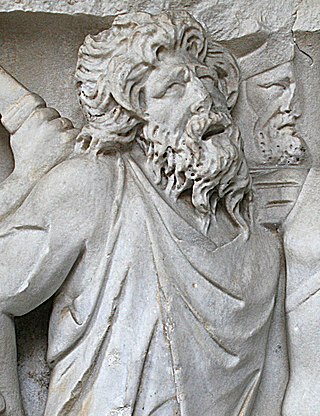
The Sarmatians were a large confederation of ancient Eastern Iranian equestrian nomadic peoples of classical antiquity who dominated the Pontic steppe from about the 3rd century BC to the 4th century AD.
Slavic or Slavonicstudies, also known as Slavistics is the academic field of area studies concerned with Slavic areas, languages, literature, history, and culture. Originally, a Slavist or Slavicist was primarily a linguist or philologist researching Slavistics. Increasingly, historians, social scientists, and other humanists who study Slavic area cultures and societies have been included in this rubric.
Slavophilia was a movement originating from the 19th century that wanted the Russian Empire to be developed on the basis of values and institutions derived from Russia's early history. Slavophiles opposed the influences of Western Europe in Russia. Depending on the historical context, the opposite of Slavophilia could be seen as Slavophobia or also what some Russian intellectuals called zapadnichestvo (westernism).
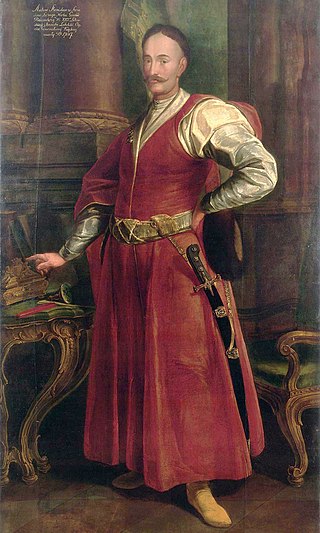
Sarmatism was an ethno-cultural ideology within the Polish–Lithuanian Commonwealth. It was the dominant Baroque culture and ideology of the nobility that existed in times of the Renaissance to the 18th centuries. Together with the concept of "Golden Liberty", it formed a central aspect of the Commonwealth's culture and society. At its core was the unifying belief that the people of the Polish–Lithuanian Commonwealth descended from the ancient Iranian Sarmatians, the legendary invaders of contemporary Polish lands in antiquity.

Michael Alfred Peszke was a Polish-American psychiatrist and historian of the Polish Armed Forces in World War II.
Marek Jan Chodakiewicz is a Polish-American historian specializing in Central European history of the 19th and 20th centuries. He teaches at the Patrick Henry College and at the Institute of World Politics. He has been described as conservative and nationalistic, and his attitude towards minorities has been widely criticized.

Richard Conrad Lukas is an American historian and author of books and articles on military, diplomatic, Polish, and Polish-American history. He specializes in the history of Poland during World War II.

Iranian studies, also referred to as Iranology and Iranistics, is an interdisciplinary field dealing with the research and study of the civilization, history, literature, art and culture of Iranian peoples. It is a part of the wider field of Oriental studies.

The Polish Institute of Arts and Sciences of America (PIASA) is a Polish-American scholarly institution headquartered in Manhattan, at 208 East 30th Street.

The Croats trace their history to the 6th and 7th-century southwards migration of the Slavs, which is supported by anthropological, genetical, and ethnological studies. However, the archaeological and other historic evidence on the migration of the Slavic settlers, the character of the native population on the present-day territory of Croatia, and their mutual relationship show diverse historical and cultural influences.
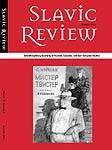
The Slavic Review is a major peer-reviewed academic journal publishing scholarly studies, book and film reviews, and review essays in all disciplines concerned with Russia, Central Eurasia, and Eastern and Central Europe. The journal's title, though pointing to its roots in Slavic studies, does not fully encompass the range of disciplines represented or peoples and cultures examined.

The Association for Slavic, East European, and Eurasian Studies (ASEEES) is a scholarly society dedicated to the advancement of knowledge about the former Soviet Union and Eastern and Central Europe. The ASEEES supports teaching, research, and publication relating to the peoples and territories within this area.

The early Slavs were a diverse group of tribal societies who lived during the Migration Period and the Early Middle Ages in Central and Eastern Europe and established the foundations for the Slavic nations through the Slavic states of the High Middle Ages. The Slavs' original homeland is still a matter of debate due to a lack of historical records; however, scholars believe that it was in Eastern Europe, with Polesia being the most commonly accepted location.
Ewa M. Thompson is a Polish-American Slavist at Rice University. One of the areas of her research concerns imperial motives in Russian literature. She was the editor of the Sarmatian Review.
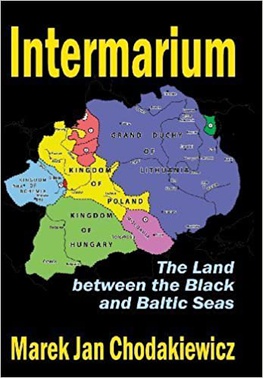
Intermarium: The Land between the Black and Baltic Seas is a 2012 book by Marek Jan Chodakiewicz about the history of Eastern Europe. It has received mixed reviews.
This is a select bibliography of English language books and journal articles about the history of Poland. A brief selection of English translations of primary sources is included. Book entries have references to journal articles and reviews about them when helpful. Additional bibliographies can be found in many of the book-length works listed below; see Further Reading for several book and chapter-length bibliographies. The External Links section contains entries for publicly available select bibliographies from universities and national libraries. This bibliography specifically excludes non-history related works and self-published books.
This is a select bibliography of English language books and journal articles about the history of Poland during World War II. A brief selection of English translations of primary sources is included. Book entries have references to journal articles and reviews about them when helpful. Additional bibliographies can be found in many of the book-length works listed below; see Further Reading for several book and chapter-length bibliographies. The External Links section contains entries for publicly available select bibliographies from universities. This bibliography specifically excludes non-history related works and self-published books.











